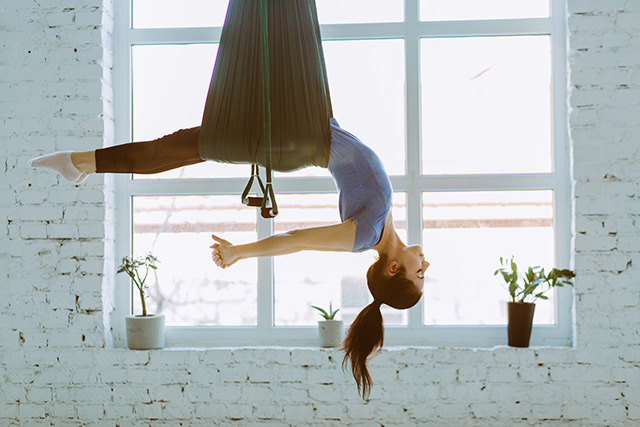A different perspective: Why getting upside down with aerial yoga is so good for your body
06/20/2019 / By Stephanie Diaz

Yoga is becoming more and more popular: It’s now one of the most commonly used complementary health approaches. In the U.S. alone, around 14 percent of adults practice this form of meditation. Children are also jumping in on the trend. According to a report released by the National Center for Health Statistics (NCHS), a principal agency of Centers for Disease Control and Prevention (CDC), about eight percent of teens and children, ages four to 17, started practicing yoga in 2017.
There are different types of yoga. Some promote meditation, while others combine both meditation and exercise. One particular type that is trending lately is aerial yoga. Aerial yoga uses hammocks attached to a ceiling — allowing practitioners to swing and perform different yoga positions that are difficult to do on a mat. In addition, being suspended in a hammock increases their range of motion and allows for deeper and more intricate poses.
Aerial yoga offers the same benefit as running or walking
A study made by Dr. Lance Dalleck of Western Colorado University (WCU), together with the American Council of Exercise, found that aerial yoga can be an alternative to traditional exercise. It offers the same benefit as more traditional types of exercise such as running and walking. To prove this, he studied the effect of aerial yoga on the cardiovascular health of women ages 18 to 45. During the six-week study, women had to do three 50-minute sessions of aerial yoga per week. Dalleck found that by the end of six weeks, women had reduced their risk of coronary heart disease (CHD) by 10 percent. Moreover, they lost around 2.5 pounds, two percent of body fat, and one inch off their waistline. Overall fitness also improved by 11 percent, and the participants had reduced their blood pressure.
While traditional yoga has been known to relive back problems, aerial yoga offers the same benefits — even more. Being suspended in a hammock allows a person to hang freely, easing the tension in the spinal cord and hip joints. Furthermore, hanging upside down can potentially ease back pain. Suspension in the air can also relieve pressure in the bones and muscles. In turn, this strengthens the core and allows greater flexibility.
Aerial yoga improves mental health and relieves stress
Like traditional yoga, aerial yoga can help relieve stress and improve focus. Hanging upside down forces people to be more aware of their body, the situation, and the surroundings. It also decreases stress hormones and increases heart rate variability, which measures stress tolerance. (Related: Yoga Takes Away Stress, Pounds, Toxins, Cholesterol and Cravings.)
Doing aerial yoga releases “happy” hormones, which are neurotransmitters needed for mood regulation. Consequently, this reduces symptoms of anxiety and depression and improves overall well-being.
In an interview in the Phnom Penh Post, Seng Bopha, a yoga instructor in Aerial BhaVana studio in Cambodia, said that the most important thing when it comes to aerial yoga is meditation.
“When we are in the air, we can float in our thoughts, especially when our body is in an upside down position and hangs from the hammock,” she said of the experience. “It is very calming.”
When done right, aerial yoga is a safe form of exercise. Yoga instructors are trained to teach how to perform aerial poses correctly. Moreover, hammocks are suspended no greater than three feet and can be adjusted accordingly. Foam wedges and other props are used to protect wrists and ankles from scuffs and prevent from bending too much.
MindBodyScience.news has more on yoga and how it helps with stress management.
Sources include:
Tagged Under: aerial yoga, anti-obesity, Anxiety, anxiety relief, beatdepression, brain health, cardiovascular health, children's health, depression, exercise, fitness, heart disease, heart health, longevity, men's health, mental health, mind body science, pain relief, prevention, slender, stress relief, women's health, yoga
RECENT NEWS & ARTICLES
COPYRIGHT © 2017 FIGHTOBESITY.NEWS
All content posted on this site is protected under Free Speech. FightObesity.news is not responsible for content written by contributing authors. The information on this site is provided for educational and entertainment purposes only. It is not intended as a substitute for professional advice of any kind. FightObesity.news assumes no responsibility for the use or misuse of this material. All trademarks, registered trademarks and service marks mentioned on this site are the property of their respective owners.



















